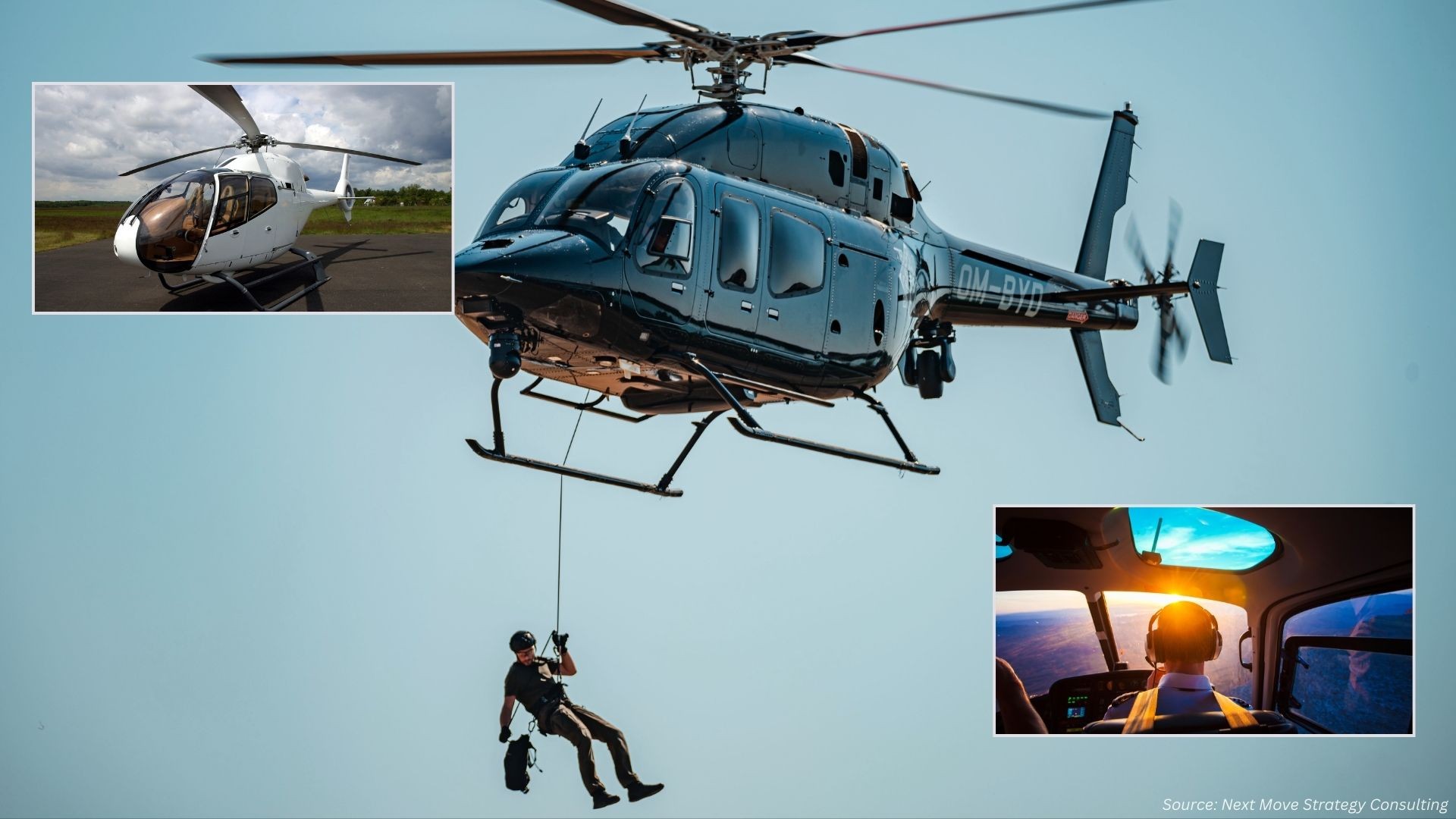What’s Driving the Helicopters Market in 2024–2025?
Published: 2025-09-26

The worldwide Helicopters Market is soaring, fueled by global demand for advanced military capabilities, innovative civilian applications, and expanded training programs. From naval upgrades in New Zealand to futuristic flying taxis in India, the industry is buzzing with developments.
Let’s dive into the trends, opportunities, and challenges shaping this dynamic market in 2024–2025.
Why Is Military Demand Fueling Helicopter Growth?
Military modernization is a key driver of the helicopters market, with nations investing heavily in advanced rotorcraft to enhance defense capabilities. Governments are prioritizing versatile, high-performance helicopters to address evolving security challenges.
-
Indian Navy’s Strategic Push: The Indian Navy issued a Request for Information (RFI) for 76 Naval Utility Helicopters (NUHs) to bolster maritime operations. These helicopters will support anti-submarine warfare, search and rescue, and troop transport, with a focus on indigenous manufacturing to reduce reliance on imports.
-
New Zealand’s Defense Upgrade: New Zealand announced a $1.57 billion investment in eight MH-60R Seahawk helicopters to replace its aging fleet, enhancing maritime surveillance and combat capabilities. This move reflects a broader trend of nations upgrading naval aviation.
-
Global Trends: Countries are increasingly seeking helicopters with advanced avionics, stealth features, and multi-mission capabilities to address diverse threats, from piracy to territorial disputes.
Military demand is propelling the helicopters market as nations like India and New Zealand invest in advanced rotorcraft to strengthen defense capabilities.
Key Points:
-
India’s RFI for 76 NUHs emphasizes indigenous production.
-
New Zealand’s $1.6 billion investment targets MH-60R Seahawks.
-
Global focus on multi-mission helicopters drives market growth.
How Are Civilian Applications Expanding the Market?
Beyond defense, civilian applications are transforming the helicopters market, with innovative uses like urban air mobility and public services gaining traction. These developments are opening new revenue streams and reshaping urban transportation.
-
Flying Taxis in India: Kerala, India, is set to launch India’s first flying taxi service in Kochi by 2026, using electric vertical takeoff and landing (eVTOL) aircraft. It can carry one pilot and up to six passengers, with a 160 km range and a top speed of 250 km/h. With just a 20-minute charging break between flights, it can operate back-to-back services.
-
Public Services and Events: In Vietnam, helicopters took to the skies for a National Day flypast in Hanoi, showcasing their role in ceremonial and public engagement activities. Such events highlight helicopters’ versatility beyond transport.
-
Market Impact: The rise of eVTOLs and civilian helicopter services is expected to grow the market, driven by urbanization and demand for rapid transit solutions.
Civilian applications, particularly eVTOLs and public service roles, are expanding the helicopters market by addressing urban mobility and ceremonial needs.
Key Points:
-
Kerala’s flying taxi service introduces eVTOLs by 2026.
-
Vietnam’s National Day flypast underscores helicopters’ public role.
-
Urban air mobility is projected to drive market growth.
What Role Does Training Play in Market Expansion?
The demand for skilled pilots and technicians is surging, prompting investments in helicopter training programs. These initiatives ensure the industry can meet growing operational needs while fostering innovation.
-
Global Training Expansion: RotorSky, a European helicopter training provider, is expanding its programs globally, offering advanced courses for pilots and maintenance crews. This reflects the industry’s need to support a growing fleet of advanced helicopters.
-
Industry Impact: Training programs are critical to sustaining market growth, as they address the shortage of qualified personnel needed to operate and maintain modern rotorcraft.
-
Technological Integration: Training now incorporates simulators and virtual reality to prepare pilots for complex missions, enhancing safety and efficiency.
Expanded training programs are vital to the helicopters market, ensuring a skilled workforce to support growing fleets and advanced technologies.
Key Points:
-
RotorSky’s global expansion addresses pilot and technician shortages.
-
Simulators and VR enhance training efficiency.
-
Training investments support market sustainability.
Who Are the Key Players in the Helicopters Market?
Leading manufacturers are driving innovation and competition in the helicopters market, delivering cutting-edge solutions for both military and civilian applications.
-
Leonardo’s Role: Leonardo, a global aerospace leader, is advancing helicopter technology with models like the AW139, widely used in military and civilian roles. Their focus on sustainability and digital integration positions them as a market frontrunner.
-
Other Players: Companies like Airbus (supplying New Zealand’s transport aircraft alongside helicopters) and Lockheed Martin (providing MH-60R Seahawks) are also key contributors, offering specialized rotorcraft for diverse needs.
-
Market Dynamics: Competition is fierce, with manufacturers investing in electric propulsion and autonomous systems to capture emerging markets like urban air mobility. The helicopters industry comprises of various market players such Airbus Helicopters SAS, Leonardo S.p.A., Bell Textron Inc., Hindustan Aeronautics Limited, Kaman Corporation, The Robinson Helicopter Company, Enstrom Helicopter Corporation, Safran Helicopter Engines, Korea Aerospace Industries, Ltd., MTU Aero Engines AG, Lockheed Martin Corporation, Kawasaki Heavy Industries, Ltd., MD Helicopters LLC., The Boeing Company, Rostec, and others. These market players continue to adopt various market development strategies including partnership to maintain their dominance in the market.
Leonardo, Airbus, and Lockheed Martin lead the helicopters market, driving innovation in military and civilian rotorcraft while competing in emerging sectors like eVTOLs.
Key Points:
-
Leonardo excels with versatile models like the AW139.
-
Airbus and Lockheed Martin supply specialized helicopters globally.
-
Innovation in electric and autonomous systems fuels competition.
What Challenges Could Slow Market Growth?
Despite its momentum, the helicopters market faces challenges that could hinder progress, including high costs, and regulatory hurdles.
-
Cost Barriers: Military helicopter programs, like New Zealand’s $1.6 billion Seahawk purchase, require significant investment, which may strain budgets in developing nations.
-
Regulatory Delays: Urban air mobility projects, such as Kerala’s flying taxis, face complex certification processes for eVTOLs, potentially delaying launches.
These challenges pose risks to the helicopters market, requiring strategic solutions to maintain growth.
Next Steps: How to Stay Ahead in the Helicopters Market
The helicopters market offers immense opportunities, but staying ahead requires proactive strategies. Here are actionable takeaways for stakeholders:
-
Invest in Training: Partner with providers like RotorSky to develop skilled pilots and technicians, ensuring operational readiness.
-
Leverage Indigenous Manufacturing: Follow India’s lead by investing in local production to reduce costs and enhance supply chain resilience.
-
Monitor Regulatory Trends: Stay updated on eVTOL certification processes to anticipate and address compliance challenges early.
-
Adopt Sustainable Technologies: Prioritize electric and hybrid helicopters to align with global sustainability goals, as exemplified by Leonardo’s innovations.
Final Thoughts:
The helicopters market in 2024–2025 is vibrant, driven by military upgrades, civilian innovations, and training expansions. By addressing challenges and seizing opportunities, stakeholders can soar to new heights in this evolving industry.
About the Author
 Sneha Chakraborty, a skilled SEO Executive and Content Writer with over 4 years in digital marketing, excels in boosting online visibility and engagement with data-driven strategies and compelling content. Passionate about simplifying digital ideas, she enjoys reading, sketching, and nature photography.
Sneha Chakraborty, a skilled SEO Executive and Content Writer with over 4 years in digital marketing, excels in boosting online visibility and engagement with data-driven strategies and compelling content. Passionate about simplifying digital ideas, she enjoys reading, sketching, and nature photography.
About the Reviewer
 Sanyukta Deb is a skilled Content Writer and Digital Marketing Team Leader, specializing in online visibility strategies and data-driven campaigns. She excels at creating audience-focused content that boosts brand presence and engagement, while also pursuing creative projects and design interests.
Sanyukta Deb is a skilled Content Writer and Digital Marketing Team Leader, specializing in online visibility strategies and data-driven campaigns. She excels at creating audience-focused content that boosts brand presence and engagement, while also pursuing creative projects and design interests.















Add Comment